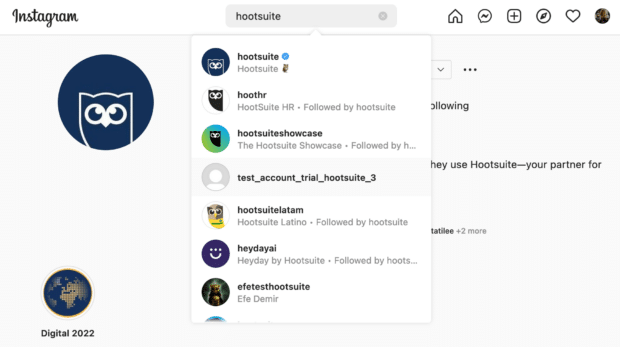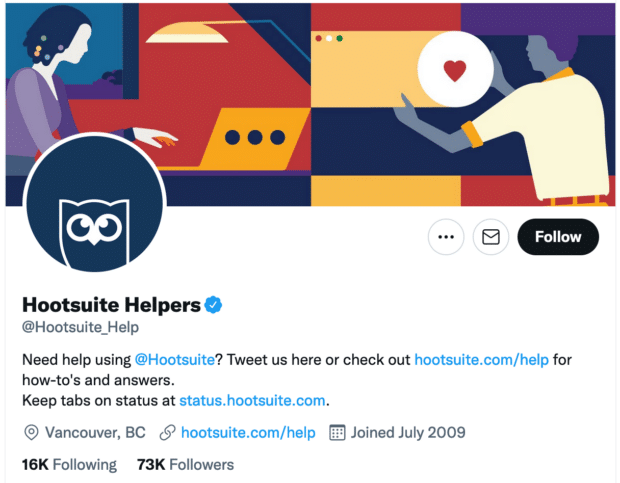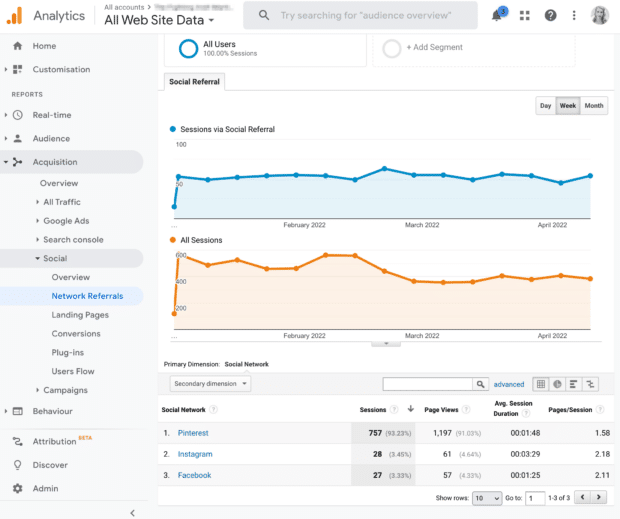Social media marketing is all fun and games until it’s time to measure your results, right? Have no fear: A social media audit is your business BFF.
A social media audit is not as scary as it sounds. Auditing your social media presence helps you understand what’s happening across all your platforms and how each one fits into your marketing goals. And with a simple template, it’s not a labor attentive or complicated process.
This post explains how to conduct an effective social media audit from start to finish. We even have a handy (and free) social media audit template to make it super easy.
Bonus: Get the free social media audit template to see what’s working and what’s not. Save time and improve performance.
What is a social media audit?
A social media audit is the process of measuring the success of your social strategy across accounts and networks. It identifies your strengths, weaknesses, and the next steps needed to improve your results going forward.
A social media audit will leave you with a laser-focused strategy for all your social media channels and the information you need to optimize your social media marketing.
You’ll know:
- Your most effective platforms,
- What your audience wants to see on each network,
- Who your audience is (demographics and more),
- What’s helping grow your audience (and what’s not),
- How each platform contributes to your goals,
- Which new ideas will help you grow,
- And where to focus your attention next.
How to perform a social media audit in 7 steps
If you’re ready to start now, download the free social media audit template above and follow along.
1. Create a list of all your social media accounts
You may think you know all your social accounts off the top of your head but chances are, you’re forgetting one or two. Start by listing all your social media profiles, including any inactive ones.
Don’t rely on company records to uncover all these accounts. What if another department decided to start a separate account without telling anyone? The only way to know is to do some digging.
Where to find this info:
Search each major social network directly for your brand and product names to see if you uncover any unexpected accounts, like old test accounts. Whoops.
Then, make a plan to deal with any troublesome accounts you’ve found. Old test ones your company has created probably won’t be too hard to get rid of (or switch to private settings), although it may be a pain to find old login info.
For imposter accounts or others infringing your copyrighted material, it’s likely the legal department will be dealing with that instead of you. Still, write down the steps needed to tackle each one. For some it could be as simple as contacting the fake account owners, or reporting the account to the social network it’s on.
Once you’re sure you’ve tracked down all relevant accounts, set up a social media monitoring program to watch for new impostors that may pop up in the future.
In addition to the accounts you have, think about the ones you don’t. Are there social platforms you don’t have a presence on? Should you start making TikTok dances? (Should anyone?) What about Nextdoor? Or Byte?
You don’t need to be on every network, but an audit is a good time to add new ideas to your social strategy for the future. If you’re unsure, at the very least reserve your business username on new platforms so no one beats you to it.
2. Check in on your branding
Look through each profile to ensure they’re all consistent with your current brand style guidelines. This includes your profile and banner images, hashtags, copy and phrases, brand voice, URLs, and more.
Here are the key areas to evaluate for each social account:
- Profile and cover images. Make sure your images reflect your current branding and adhere to each social network’s image size requirements.
- Profile/bio text. You have limited space to work with when creating a social media bio, so it’s important to make the most of it. Are all fields filled in accurately? Does the copy in your “about” section match your tone and voice guidelines?
- Username. Are you using the same username across all social channels? It’s a good idea to do so if you can. Of course, you may have more than one account per network if they serve different purposes. (For example, our Twitter accounts @Hootsuite and @Hootsuite_Help.)
- Links. Does the URL in your profile go to the correct website or landing page?
- Pinned posts (if applicable). Evaluate your pinned posts to ensure they’re still appropriate and up-to-date.
- Verification. Is your account verified with a blue check mark badge? If not, should you try? We have guides on exactly how to get verified on Instagram, Twitter, and Facebook if this is something you want to pursue.
3. Identify your top-performing social media content
For each social profile, list your top five posts. Copy the post links into your social media audit template so you can easily review them later.
What makes a “top-performing post?” We suggest ranking them by engagement rate to find the content your audience resonates with most. However, you may want to choose a different key metric to focus on, like link clicks or conversions.
Look through your top posts for patterns. In the paraphrased words of Snoop Dogg, keep your mind on your metric (and your metric on your mind) and ask yourself:
- What’s getting you the response you want? Photo posts? Videos? Feed, Stories, or Reels?
- What has the highest engagement: Candid, behind the scenes content or polished and pro posts?
- Are people responding in the same ways across all networks, or does a certain type of content perform better on one platform than others?
- Do people engage with your posts if you ask a question?
- Are your top posts aligned with your current brand voice? (If not, and they’re performing well, maybe it’s time to re-evaluate that voice.)
Use the notes column of your audit document to record your thoughts. We’ll come back to these notes later in the audit process to brainstorm new social marketing strategies.
Where to find this info:
You can use the built-in analytics tools for each social network to sort and find your top posts for the key metric you’ve chosen. Not sure how? We have complete guides to using all of them:
- Twitter analytics guide
- Facebook analytics guide
- Instagram analytics guide
- TikTok analytics guide
- LinkedIn analytics guide
- Pinterest analytics guide
- Snapchat analytics guide
But hold up: That could take forever. Make life easier and use Hootsuite Analytics to find the top posts for all your social accounts in one place with just a few clicks.
Hootsuite Analytics delivers valuable insights to inform your social strategy, both during this audit and all the time:

Try Hootsuite for free. (You can cancel anytime.)
Learn more about how to use Hootsuite Analytics in this 2-minute video.
4. Evaluate each channel’s performance
Now it’s time to take a 10,000ft view of each of your social accounts. This step evaluates how each social channel contributes to your overall marketing goals.
Bonus: Get the free social media audit template to see what’s working and what’s not. Save time and improve performance.
If you haven’t already created a mission statement and a few key goals for each social account, now’s the time.
Several accounts may have similar goals, such as driving web traffic and conversions. Others may be exclusively for customer service purposes or brand awareness. For example, our YouTube account is all about product education, but our @Hootsuite_Help Twitter account is only for tech support:
For each channel, list out its goal(s) and track your progress toward them. For measurable goals like traffic or conversions, write down the actual numbers.
How many website visits came from Instagram? How many sales came from Facebook Page visitors? If the goal is customer service, write down your CSAT score and see if it’s improving over time. Be specific.
For goals without quantifiable data, record supporting evidence. If your Facebook account is for brand awareness, has your following grown? Have you increased your organic or paid reach?
The point here is to understand the purpose of each of your social channels and measure their effectiveness.
Where to find this info:
Finding relevant information will depend on the goals you set for each channel. For customer service or brand awareness goals, using social listening tools gives you data from real customers.
For traffic or conversion goals, most of this information is in Google Analytics. You can view the traffic breakdown by channel (plus a lot more information) by going to Acquisition -> Social -> Network Referrals.
Tracking conversions from social media isn’t an exact science, though it’s easier on some channels than others. You’ll need to set up Meta Pixel (formerly Facebook Pixel) to track Facebook conversion data, for example, and many networks have their own tracking codes. Many e-commerce platforms also have built-in social channel tracking.
Once again, you can make your life much easier by using a social media management tool like Hootsuite Analytics for this, too. Here’s a quick overview of how it works, including how to track conversions efficiently with repeatable reports you can run in a few seconds:
Try Hootsuite for free. (You can cancel anytime.)
5. Understand your audience on each platform
Now that you know how each account is helping support and grow your brand, it’s important to understand who you’re reaching on each platform.
Audience demographics are a good starting point. For example, Instagram gets a lot of attention for its ecommerce features, but consumers actually spend the most money on TikTok. Facebook is the most popular platform for people 35-44, but YouTube is the place to be for the 18-25 group.
While your audience may differ from the norm, we’ve compiled all the top demographic data for each social network to get you started:
- Facebook demographics
- Twitter demographics
- Instagram demographics
- TikTok demographics
- LinkedIn demographics
- Snapchat demographics
- Pinterest demographics
- YouTube demographics
Learn the demographics of your unique audience on each platform and use that, along with the types of posts they prefer, to create buyer personas. Don’t worry, we’ve got a free buyer persona template to make that easy for you, too.
Where to find this info:
Like the other metrics we’ve talked about, you can find demographic information within each platform’s reporting, or much more easily with the all-in-one audience reporting in Hootsuite Insights.
6. Take action: Update your social media marketing strategy
Now that you know your goals and current performance for each platform, think about ways to improve. Revisit your notes from earlier steps as you plan the next month or quarter ahead.
A few questions to ask yourself:
- Which platforms are driving the most results?
- Are there any new social media platforms you should be using?
- Are you neglecting any platforms? Do you even need them, or would it be a better use of your time to ditch them and focus on your higher-performing ones?
- What content types are working best right now? How can you make more of this?
Think about new content and campaign ideas, building off what you learned from your top content in step three. If video is a big hit, write down a specific strategy to work more of it into your marketing. That could be, “Post 3 new Instagram Reels per week,” or, “Repurpose existing longform video into short, 15-second clips for social media.”
These decisions don’t have to be forever. Successful marketing depends on running tests and experiments to find what works for your audience. Don’t be afraid to take risks. Your regular social media audits will let you know if you’re on the right track or need to go a different direction.
For each new strategy and idea, write it down in your marketing plan. (Don’t have one yet? We gotcha with yet another awesome template: this free social media marketing plan document.) Your marketing strategy is a living document: Keep it current.
Where to find this info:
Your brain! Use all the data you’ve collected so far to generate new ideas. Have your goals for each platform in front of you so that you can connect your updated marketing plan to them. Remember to let others know when you’ve updated the marketing plan so everyone is on the same page.
Once you’re done with your audit… plan the next one! Stick to a regular schedule. Quarterly works well for most companies, although if you run a lot of campaigns or channels, you may want to check in monthly.
Regular audits connect your team’s day-to-day marketing work with your company goals. Over time, you’ll refine your social strategy and learn how to best connect with your audience.
Free social media audit template
Bonus: Get the free social media audit template to see what’s working and what’s not. Save time and improve performance.
The best way to keep track of your social media audit information (and everything in life) is to use a spreadsheet.
We’ve created a ready-to-use social media audit template for you. Download it above, or make your own with the following fields:
Account details:
- your username
- link to your profile
- about/bio text for the account
- any hashtags that appear in your bio or that you’ll regularly use
- URL to use in your bio
- whether your account is verified or not
- internal person or team responsible for managing the account (also known as the “owner”—for example, the social marketing team)
- mission statement for the account (for example: “To promote company culture using employee photos,” or, “To provide customer service.”)
- details of the current pinned post (if applicable)
- date of the most recent post (to help you identify underused/abandoned accounts)
Performance details:
- total number of posts published
- total engagement numbers: Engagement rate, click-through rate, views, comments, shares, etc
- change in engagement rate vs. your last audit
- the top five posts for each platform by engagement rate (or the key metric you’ve chosen)
- your campaign ROI (optional, if you run paid ads)
Audience details:
- demographics and buyer personas
- follower count (and change +/- vs. your last audit)
Goals:
- 2-3 S.M.A.R.T. goals you want to achieve by your next audit
- whether you met the goals you set for this audit, or changed course (and why)
Now you know everything you need to conduct your own social media audit. Go forth and analyze!
Save time by managing all your accounts in one place with Hootsuite. Plan content and campaigns, schedule posts, manage conversations, and see all your analytics and ROI data with quick, automated reports. Power up your social marketing today.
All your social media analytics in one place. Use Hootsuite to see what’s working and where to improve performance.
The post How to Run the Easiest Social Media Audit [FREE TEMPLATE] appeared first on Social Media Marketing & Management Dashboard.
![How to Run the Easiest Social Media Audit [FREE TEMPLATE]](https://localseoresources.com/wp-content/uploads/2022/04/social-media-audit-1-620x347.png)









Recent Comments